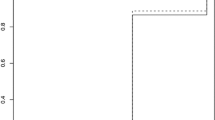Abstract
This article obtains demand functions for risky assets without making a priori assumptions about the form of the utility function. In a simple portfolio model, the envelope theorem is applied to the indirect expected utility function to derive estimating equations. Tests for the existence of constant absolute or constant relative risk aversion are also developed. Empirical estimation of the demand for financial assets held by U.S. households for the period 1946–1985 indicates that aggregate household behavior is consistent with the existence of constant relative risk aversion, with the coefficient of risk aversion having a value of approximately 1.3.
Similar content being viewed by others
References
Abel, Andrew B. (1991). “The Equity Premium Puzzle,”Business Review, Federal Reserve Bank of Philadelphia September–October, 3–14.
Arrow, K. J. (1971).Essays in the Theory of Risk-Bearing. Chicago: Markham.
Blackorby, C., D. Primont, and R. Russell. (1978).Duality, Separability, and Functional Structure: Theory and Economic Applications. New York: North-Holland.
Christensen, L., D. W. Jorgenson, and L. J. Lau. (1975). “Transcendental Logarithmic Utility Functions,”American Economic Review 65, 367–383.
Dalal, A. J. (1983). “Comparative Statics and Asset Substitutability/Complementarity in a Portfolio Model: A Dual Approach,”Review of Economic Studies 50, 355–367.
Dalal, A. J. (1988). “Asset Demands and Slutsky Equations When All Assets are Risky,”Metroeconomica 39, 205–221.
Denny, M., and M. Fuss. (1977). “The Use of Approximation Analysis to Test for Separability and the Existence of Consistent Aggregates,”American Economic Review 67, 404–418.
Ibbotson, R. G., and R. A. Sinquefleld. (1986).Stocks, Bonds, Bills and Inflation: Historical Returns. Charlottesville, VA: Financial Research Foundation.
Kendall, L. T. (1962).The Savings and Loan Business. Englewood Cliffs, NJ: Prentice Hall.
Mehra, Rajnish, and Edward C. Prescott. (1985). “The Equity Premium: A Puzzle,”Journal of Monetary Economics 15, 145–161.
Ornstein, F. H. (1985).Savings Banks. Charlottesville, VA: Reston.
Pindyck, R. S. (1988). “Risk Aversion and Determinants of Stock Market Behavior,”Review of Economics and Statistics 70, 183–190.
Saito, M. (1977). “Household Flow-of-Funds Equations,”Journal of Money, Credit and Banking 19, 1–20.
Sandmo, A. (1977). “Portfolio Theory, Asset Demand and Taxation: Comparative Statics with Many Assets,”Review of Economic Studies 44, 369–379.
Silberberg, E. (1978).The Structure of Economics: A Mathematical Analysis. New York: McGraw-Hill.
Author information
Authors and Affiliations
Additional information
The authors gratefully acknowledge helpful comments from the editor and an anonymous referee.
Rights and permissions
About this article
Cite this article
Dalal, A.J., Arshanapalli, B.G. Estimating the demand for risky assets via the indirect expected utility function. J Risk Uncertainty 6, 277–288 (1993). https://doi.org/10.1007/BF01072615
Issue Date:
DOI: https://doi.org/10.1007/BF01072615




